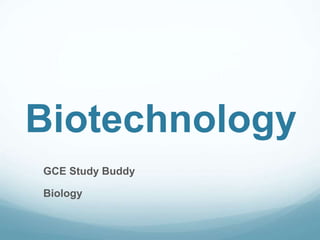biotechnology.pptx
•Download as PPTX, PDF•
0 likes•1 view
dfsdfs fssf
Report
Share
Report
Share

Recommended
Recommended
More Related Content
Similar to biotechnology.pptx
Similar to biotechnology.pptx (20)
Microorganisms Friend OR foe- made by saksham gupta

Microorganisms Friend OR foe- made by saksham gupta
Unit2IndustrialimportanceofFungi_3pptx__2023_02_21_09_21_08 (1).pptx

Unit2IndustrialimportanceofFungi_3pptx__2023_02_21_09_21_08 (1).pptx
More from sahibzadamohsinbaloc
More from sahibzadamohsinbaloc (12)
Recently uploaded
Recently uploaded (20)
Basic Civil Engineering first year Notes- Chapter 4 Building.pptx

Basic Civil Engineering first year Notes- Chapter 4 Building.pptx
Unit-V; Pricing (Pharma Marketing Management).pptx

Unit-V; Pricing (Pharma Marketing Management).pptx
Fostering Friendships - Enhancing Social Bonds in the Classroom

Fostering Friendships - Enhancing Social Bonds in the Classroom
UGC NET Paper 1 Mathematical Reasoning & Aptitude.pdf

UGC NET Paper 1 Mathematical Reasoning & Aptitude.pdf
This PowerPoint helps students to consider the concept of infinity.

This PowerPoint helps students to consider the concept of infinity.
ICT role in 21st century education and it's challenges.

ICT role in 21st century education and it's challenges.
Food safety_Challenges food safety laboratories_.pdf

Food safety_Challenges food safety laboratories_.pdf
HMCS Vancouver Pre-Deployment Brief - May 2024 (Web Version).pptx

HMCS Vancouver Pre-Deployment Brief - May 2024 (Web Version).pptx
On National Teacher Day, meet the 2024-25 Kenan Fellows

On National Teacher Day, meet the 2024-25 Kenan Fellows
Kodo Millet PPT made by Ghanshyam bairwa college of Agriculture kumher bhara...

Kodo Millet PPT made by Ghanshyam bairwa college of Agriculture kumher bhara...
General Principles of Intellectual Property: Concepts of Intellectual Proper...

General Principles of Intellectual Property: Concepts of Intellectual Proper...
biotechnology.pptx
- 2. Types of Micro-organisms ●Bacteria ●Viruses ●Fungi eg. Mucor , Rhizopus ●Protozoa eg. Amoeba, Paramecium ●algae (unicellular / colonial form)
- 3. Useful Micro-organisms ●yeast ○carry out alcoholic fermentation in the presence of carbohydrates & the absence of O2 ○baking bread ■produces carbon dioxide to raise the dough ○brewing beer / making wine ■fermentation to produce alcohol ●nitrogen-fixing bacteria in leguminous plant [root nodules] ○carry out nitrogen fixation which changes N2 gas from the air to nitrogenous compounds for plants to produce protein ●decomposers & nitrifying bacteria ○decomposers decompose organic waste & dead body into ammonia ○nitrifying bacteria change ammonia into nitrate for plants to make protein
- 4. Harmful Micro-organisms ●disease causing (pathogens) ○bacterial disease : e.g. cholera, sore throat, tuberculosis ○viral disease : e.g. AIDS, bird flu, common cold, influenza ○fungal disease : e.g. athlete’s foot , ringworm ○protozoa disease : e.g. malaria, sleeping sickness ●bacteria ○prokaryotic cells (without nuclear membrane) ○reproduce by binary fission ○some are pathogenic, some are useful ●viruses ○with only DNA/RNA + protein coat ○all are parasitic (they are considered living only when they are inside living cells)
- 5. ●decay food & other useful materials ○microorganisms are saprophytic ○take in decaying food: cause food poisoning Harmful Micro-organisms
- 6. Antibiotics ●chemicals produced by microorganisms which can kill or stop the growth of bacteria & fungi ○e.g. penicillin ●importance: effective in treating many diseases such as meningitis, syphilis, etc ●Broad-spectrum antibiotics: ○can attack many different strains of bacteria ●Narrow-spectrum antibiotics ○can attack only one or a few strains of bacteria
- 7. Clear zone - indicates the absence of bacteria which had been killed by the antibiotic Antibiotics Clear zone with larger diameter indicates a more powerful antibiotic against the bacteria
- 8. Food Preservation 1. Heating ●kill most microorganisms & their spores by high temperature 2. Canning & Bottling ●sealing in cans to avoid bacterial entry ●should work together with sterilization 3. Pasteurization ●kill most microorganisms without changing the flavour of milk ●75 ℃ for 15s and then quickly cooled & bottled 4. UHT (Ultra High Temperature) treatment ●common in killing bacteria in milk ●superheat to ~150℃ for a few seconds and then sealed 5. Refrigeration ●to decrease or stop the activities & growth of microorganisms (NOT killing them) 6. Freezing 7. Drying (Dehydration) ●micro-organism dies due to water deficiency 8. Smoking ●dry, coat with smoke which has chemical to stop bacterial growth 9. Pickling ●add vinegar (usually together with salt) ●kill bacteria by acid 10. Osmotic preservation ●by adding salt or sugar ●to remove water from micro- organisms by osmosis 11. Irradiation ●expose food to radiation ●kill bacteria and moulds & prevent